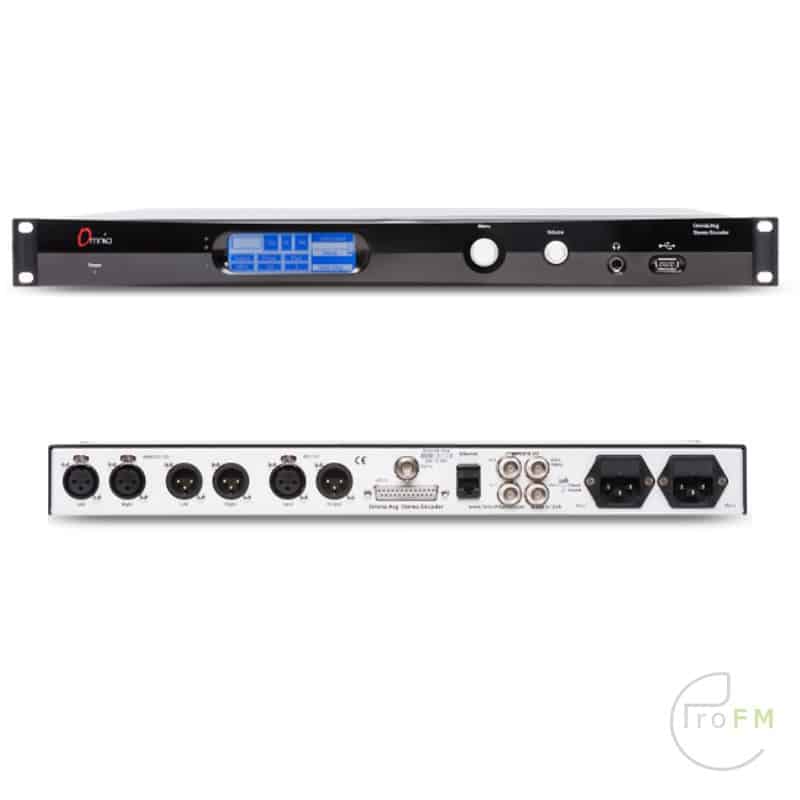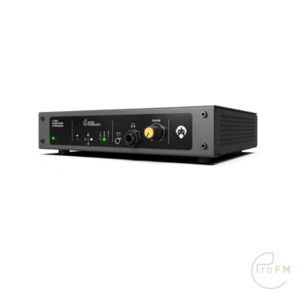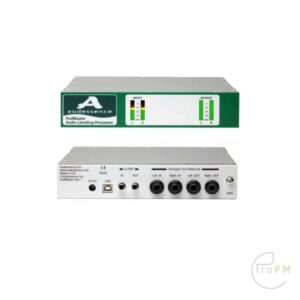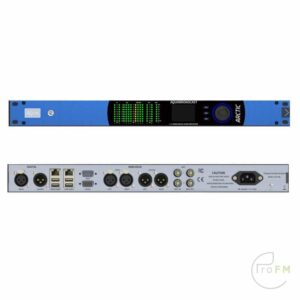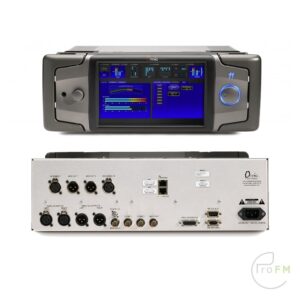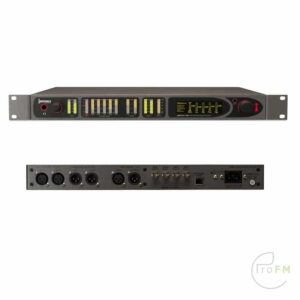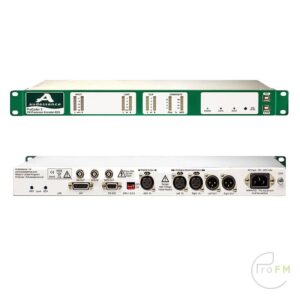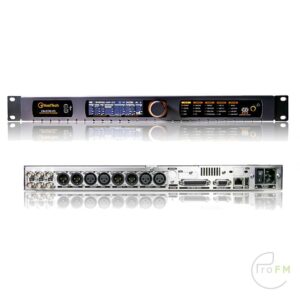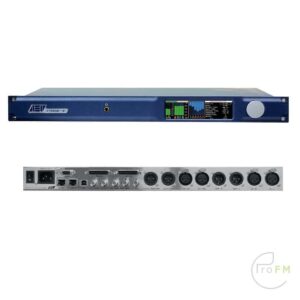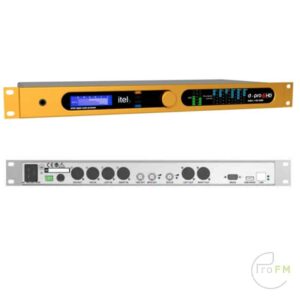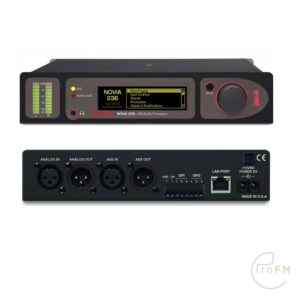Description
Omnia 9sg FM Stereo Generator
We know that the main processor must be installed at either the studio or at the transmitter. Each location has its advantages and disadvantages. Placing a processor at the studio is often more convenient as some transmitter sites are difficult to access, but doing so can compromise quality and loudness as STL audio quality varies and the clippers found in other stereo generators are often mediocre at best. Some transmitters have built-in stereo generators but quality and features vary.
Placing the processor at the transmitter site allows the composite signal from the processor to be fed directly into the transmitter, which provides the best audio quality and the most loudness, but not all transmitter sites have adequate network connectivity for remote control and are often located in remote or difficult-to-access areas. This means making adjustments to the processing is often a challenge.
Split processing—placing the main processor at the studio and performing final stage limiting and stereo generation at the transmitter—can be an ideal, no-compromise solution with the Omnia 9sg.
The processor-agnostic Omnia.9sg was always more than just a stereo generator. With the latest software, this final-stage processor takes its next leap forward with a new clipper design, Livewire AES67, audio playout with internal processing for localization or backup, and more.
Features
• Full IP remote with remote audio streaming. Because transmitters are often located in hard-to-reach
locations, full-featured remote access is critical.
• Optional RDS encoder supports UECP protocol, allowing each Omnia.9sg to be individually addressed
to customize and localize RDS information.
• Built-in http server with push support for dynamic RDS data (with optional internal RDS encoder
option).
• Selectable SSB (single sideband) stereo encoding makes SSB compatible with nearly all receivers.
• RF bandwidth controller reduces multipath distortion.
• ITU-R BS.412 power limiter for European countries.
• Auto Pilot turns off pilot for mono content, reducing noise, great for spoken word/news/talk/sports
formats.
• Relay bypass including composite pass-through. Should Omnia.9sg fail or lose power, a backup
standalone processor can be fed through it and be put on-air automatically and immediately.
• Built-in internal playback capability with processing. Should normal audio be lost, the built-in player in
Omnia.9sg can immediately and automatically provide back-up content and audio processing until the
problem is resolved.
• Optional local audio insertion allows each Omnia.9sg to interrupt normal program audio and insert
local content such as traffic, weather, and geo-targeting advertising, with audio processing.
• “Omnia Toolbox” features including oscilloscope, FFT, and RTA, valuable signal-analysis tools built right
into the product, eliminating the need for standalone engineering tools.
• Dual redundant power supplies. Back up if one supply fails. Each supply can be fed from a different
electrical circuit; if one circuit fails, the unit stays on air.
• Two composite inputs, two composite outputs. A “hot” backup processor can be looped through the
Omnia.9sg and be automatically and immediately placed on air should the 9sg fail or lose power; also
makes it possible to use an external RDS encoder if desired.
• Built in stream receiver allows for a web stream to serve as an additional audio source
• Optional Kantar-certified watermarking support
Frequency Response:
/- .5 dB 20 Hz to 15 kHz
Signal-Noise Ratio:
Greater than -80 dBu de-emphasized, 20 Hz to 15 kHz
Stereo Separation:
65 dB minimum, 20 Hz to 15 kHz, 70 dB typical
Stereo Baseband Output:
Adjustable from -2 dBu to 22 dBu (0.1 dB increments) into 600-Ohms, 20-Ohm output impedance
Analog Inputs:
Two balanced, EMI filtered XLR connectors
Digital Inputs:
AES/EBU In & External Sync
Composite I/O:
Four 75-Ohm BNC female, two inputs, two outputs
Remote Control:
RJ45 supporting 100BASE-T Ethernet connections
Power Requirements:
100-264 VAC, 47-63Hz autosensing, dual PSU
Power Connector:
Dual IEC male, detachable 3-wire power cords supplied
Environmental:
Operating: 0 to 50 degrees C
Non-Operating: -20 to 70 degrees C
Regulatory
North America: FCC and CE tested and compliant, power supply is UL approved.
Europe: Complies with the European Union Directive 2002/95/EC on the restriction of the use of certain hazardous substances in electrical and electronic equipment (RoHS), as amended by Commission Decisions 2005/618/EC, 2005/717/ EC, 2005/747/EC (RoHS Directive), and WEEE.
- Description
-
Omnia 9sg FM Stereo Generator
We know that the main processor must be installed at either the studio or at the transmitter. Each location has its advantages and disadvantages. Placing a processor at the studio is often more convenient as some transmitter sites are difficult to access, but doing so can compromise quality and loudness as STL audio quality varies and the clippers found in other stereo generators are often mediocre at best. Some transmitters have built-in stereo generators but quality and features vary.
Placing the processor at the transmitter site allows the composite signal from the processor to be fed directly into the transmitter, which provides the best audio quality and the most loudness, but not all transmitter sites have adequate network connectivity for remote control and are often located in remote or difficult-to-access areas. This means making adjustments to the processing is often a challenge.
Split processing—placing the main processor at the studio and performing final stage limiting and stereo generation at the transmitter—can be an ideal, no-compromise solution with the Omnia 9sg.
The processor-agnostic Omnia.9sg was always more than just a stereo generator. With the latest software, this final-stage processor takes its next leap forward with a new clipper design, Livewire AES67, audio playout with internal processing for localization or backup, and more.
Features
• Full IP remote with remote audio streaming. Because transmitters are often located in hard-to-reach
locations, full-featured remote access is critical.
• Optional RDS encoder supports UECP protocol, allowing each Omnia.9sg to be individually addressed
to customize and localize RDS information.
• Built-in http server with push support for dynamic RDS data (with optional internal RDS encoder
option).
• Selectable SSB (single sideband) stereo encoding makes SSB compatible with nearly all receivers.
• RF bandwidth controller reduces multipath distortion.
• ITU-R BS.412 power limiter for European countries.
• Auto Pilot turns off pilot for mono content, reducing noise, great for spoken word/news/talk/sports
formats.
• Relay bypass including composite pass-through. Should Omnia.9sg fail or lose power, a backup
standalone processor can be fed through it and be put on-air automatically and immediately.
• Built-in internal playback capability with processing. Should normal audio be lost, the built-in player in
Omnia.9sg can immediately and automatically provide back-up content and audio processing until the
problem is resolved.
• Optional local audio insertion allows each Omnia.9sg to interrupt normal program audio and insert
local content such as traffic, weather, and geo-targeting advertising, with audio processing.
• “Omnia Toolbox” features including oscilloscope, FFT, and RTA, valuable signal-analysis tools built right
into the product, eliminating the need for standalone engineering tools.
• Dual redundant power supplies. Back up if one supply fails. Each supply can be fed from a different
electrical circuit; if one circuit fails, the unit stays on air.
• Two composite inputs, two composite outputs. A “hot” backup processor can be looped through the
Omnia.9sg and be automatically and immediately placed on air should the 9sg fail or lose power; also
makes it possible to use an external RDS encoder if desired.
• Built in stream receiver allows for a web stream to serve as an additional audio source
• Optional Kantar-certified watermarking support - Specifications
-
Frequency Response:
/- .5 dB 20 Hz to 15 kHz
Signal-Noise Ratio:
Greater than -80 dBu de-emphasized, 20 Hz to 15 kHz
Stereo Separation:
65 dB minimum, 20 Hz to 15 kHz, 70 dB typical
Stereo Baseband Output:
Adjustable from -2 dBu to 22 dBu (0.1 dB increments) into 600-Ohms, 20-Ohm output impedance
Analog Inputs:
Two balanced, EMI filtered XLR connectors
Digital Inputs:
AES/EBU In & External Sync
Composite I/O:
Four 75-Ohm BNC female, two inputs, two outputs
Remote Control:
RJ45 supporting 100BASE-T Ethernet connections
Power Requirements:
100-264 VAC, 47-63Hz autosensing, dual PSU
Power Connector:
Dual IEC male, detachable 3-wire power cords supplied
Environmental:
Operating: 0 to 50 degrees C
Non-Operating: -20 to 70 degrees CRegulatory
North America: FCC and CE tested and compliant, power supply is UL approved.
Europe: Complies with the European Union Directive 2002/95/EC on the restriction of the use of certain hazardous substances in electrical and electronic equipment (RoHS), as amended by Commission Decisions 2005/618/EC, 2005/717/ EC, 2005/747/EC (RoHS Directive), and WEEE.

